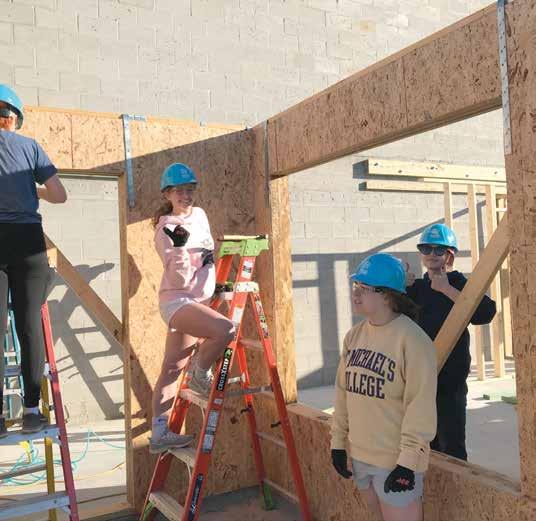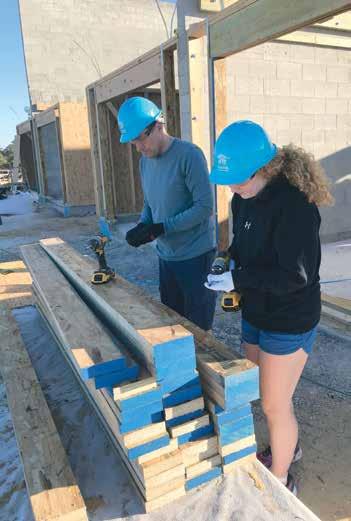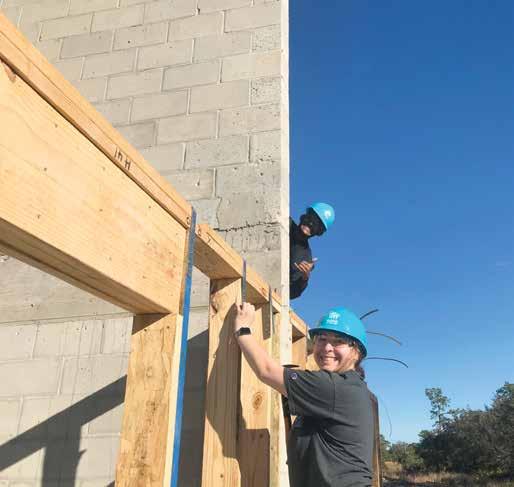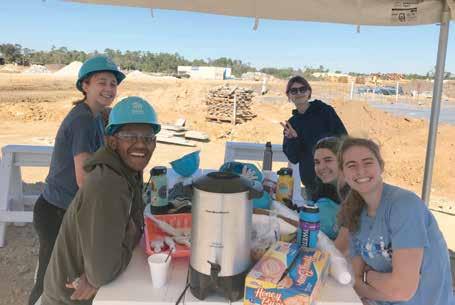
5 minute read
Action: Immokalee, FL
What I hadn’t accounted for was the quality of St. Mike’s student who volunteers for this type of service work each year. The six students who accompanied me were ready to get straight to task, learn new skills, meet new people, ask good questions, and get their hands dirty. I had told them about our previous experience working inside homes in a Habitat for Humanity neighborhood where we installed insulation, trim, and cabinets as well as caulked and painted. I drove the students from the airport straight to the neighborhood we had worked on and explained all the change I was witnessing, with children playing in yards and families living in all the homes. It was quite rewarding to see.
When we arrived on Day One to the coordinates we had been provided to locate the job site, I was taken aback, as we had to hike in a quarter mile to a single foundation with three two-story cinderblock walls in the center of a 100 acre clear-cut just south of the town. The foreman informed us that this was the first unit of a 10-year project to house 284 families and would be the second largest Habitat project in history. We were given hard hats and goggles and pointed toward our tasks. I knew four of the crew members from last year and was happy to greet Ernesto, Jaime, Adrian, and Miguel. They gave us 30 seconds of instruction and pointed at several tools and left us to get to work, a test to see what we might be capable of and if we needed our hands held for the week. I reiterated our tasks to the students and then we broke down and reset scaffolding, used impact drills and ratchets to bolt lumber to the walls and foundations, nailed strapping, hauled lumber, sawed boards, painted sawhorses, and screwed piles of framing together over the course of the week for the first unit and for the three additional foundations that were poured while we were there. Our students were smiling the whole time as they sweat in the hot sun and saw the progression of their work each day.

At one point during the week, Miguel pulled me aside and paid me the highest compliment he could have about our students. He said, “Each year, you bring a really good group from your school. They show up, work hard, get so much done, and they do not try to impose their politics onto our job site. That doesn’t happen with other groups.” My mind went straight to our departure dinner with Lara and Vicky, realizing that our students had taken the message from the Selma missionaries to heart and were living it in practice. I would have been proud of their work regardless, but now I was positively glowing.

Our worksite in the afternoons was the RCMA School for the children of migrant workers in Immokalee. It is a private charter school serving the community through bilingual instruction. The amazing part of the curriculum is that the children are mostly English-speaking Americans and they are learning their parents’ native language in half of their instruction. Two of the St. Mike’s students bravely volunteered to be in immersive Spanish classes, very much outside their comfort zones. We were embedded into classrooms K-8 for the remainder of each school day, and then would stay for the after-school program. Most of the kids are at the school from 6 a.m. until 5:30 p.m., which is the typical workday for their parents, who primarily pick the tomatoes for our supermarkets and restaurants September through May. It is an extremely long day for the kids, and our presence brings some freshness to their long days. Several of the kids in the first grade remembered me from the year before and I was greeted like a celebrity when I walked into the classroom for the first day and heard, “It’s George!” Of course, this meant that I had multiple little kids in uniforms hanging from every limb I had for the remainder of the week, and I loved every minute of it. The St. Mike’s students followed my lead on the playground and wasted no time making friends. We were not lacking for exercise by the time we exited the school each day.
The free time that our group had was spent three ways: driving in our van, bonding at the house preparing meals or playing card games, or hiking rail trails in county parks to see alligators and birds. Each of these activities allowed us to develop strong bonds over the course of the week and although I started the week believing I was the “cool uncle” figure to these 19- and 20-year-olds, by the third or fourth day reality brought me to the realization that I was the dad in the group. I got to do all the driving, give sound advice on the job sites to help them succeed, teach everyone how to chop and prepare food each day, and take out the trash while making sure everyone was cleaning up. All of these things were a joy to me because the students were well behaved, engaged in all their tasks, and working together selflessly. Each of them made me fond of them in their own unique way, coming from diverse backgrounds and allowing themselves to be fully present the entire week. There were no egos, problems, or struggles to get anyone to put down their mobile devices! Any apprehensions I harbored dissipated within the first few days we were there. There was a bit of competitive jostling and shouting as we competed to count yellow cars we passed each day while driving many miles in our van.
On each of the service trips that MOVE sponsors, reflection on the work and your place in it are a large part of the experience. The students were all very open, honest, and thoughtful in sharing with each other. As the parent of a current first-year student at St. Mike’s, I had my faith restored in the kinds of students we are attracting and helping to grow further. These young people had very thoughtful responses to their service work, and it was rewarding to me to be able to help them give themselves to this work.
I returned to campus feeling very much richer for the experience and truly believing I had six new friends on campus. I knew from listening to them that they all had appreciated the week together, but I came away feeling that I had gained so much from them during the week and found myself invigorated as we began a new semester.

Literacy Moves Outdoors: Learning Approaches for Any Environment
By Valerie Bang-Jensen (Heinemann)
Professor Bang-Jensen’s latest book was published this spring. The book, written for K-6 teachers, features five approaches to teaching literacy outdoors, including StoryWalks and Word Gardens. Visit smcvt.edu/magazine for a link to hear a podcast conversation about the book with Professor Bang-Jensen.
Raven
By Mark Roddy ’70
(Austin
Macauley Publishers)
Raven is a story set in mid-1943 of a German agent who, at the behest of Japanese allies, was sent by his country to sabotage the U.S. Navy’s torpedo factory in Newport, Rhode Island.
Angela’s Letter
By Mark Roddy ’70
(Austin
Macauley Publishers)
Angela’s Letter is about two people, both widowed, and the challenges and joys they face trying to see if they can rekindle the love they shared many years earlier.







